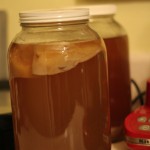 Kombucha tea is said to aid in digestion, immunity, energy, weight loss, and more, and has become a very popular health food drink in America. Many claim Kombucha to be a wonder drink or elixir, used to address almost any ailment. With its effervescence tangy, sweet taste, it is a perfect replacement for processed sodas, energy drinks, or even beer and wine (although Kombucha is non-alcoholic). While delicious, pre-made options are available in most health food stores, store-bought Kombucha is astronomically more expensive than making it at home. You just have to be a little patient and work on your method until you get it just right. You can also add flavors to fully brewed tea such as freshly grated ginger, lemon, or a small amount of concentrated fruit juice. This is a cultured food, so once you invest in the equipment and your first starter “scoby” (the mushroom/fungus used to ferment the tea), the “mother” will produce “babies” every time your brew and ferment the tea, so you will be able to continue making this tea forever, as well as help your friends and family start brewing themselves!
Kombucha tea is said to aid in digestion, immunity, energy, weight loss, and more, and has become a very popular health food drink in America. Many claim Kombucha to be a wonder drink or elixir, used to address almost any ailment. With its effervescence tangy, sweet taste, it is a perfect replacement for processed sodas, energy drinks, or even beer and wine (although Kombucha is non-alcoholic). While delicious, pre-made options are available in most health food stores, store-bought Kombucha is astronomically more expensive than making it at home. You just have to be a little patient and work on your method until you get it just right. You can also add flavors to fully brewed tea such as freshly grated ginger, lemon, or a small amount of concentrated fruit juice. This is a cultured food, so once you invest in the equipment and your first starter “scoby” (the mushroom/fungus used to ferment the tea), the “mother” will produce “babies” every time your brew and ferment the tea, so you will be able to continue making this tea forever, as well as help your friends and family start brewing themselves!
| Kombucha Tea |
- 3 quarts filtered water
- 1 cup sugar (Evaporated Cane Juice Sugar suggested)
- Four black tea bags (Organic Orange Pekoe Black Tea suggested)
- 1 kombucha mushroom or “scoby”, available from:
- www.GEMcultures.com or www.Kombucha2000.com
- 1 cup kombucha from previous batch (will come with purchased scoby)
- Bring 3 quarts of distilled or purified water to boil in a stainless steel cooking pot (stock pot).
- When boiling, add one cup (8oz.) of organic evaporated cane juice sugar. Boil for five minutes.
- Turn off the heat, remove the cooking pot (in order to stop the boiling). Add four organic Orange Pekoe black tea bags or 4 teaspoons in a stainless steel tea ball, cover the pot with the lid. Let steep for 15 minutes.
- Remove and discard tea bags or empty tea ball.
- Allow sweetened tea to cool to room temperature, even if it takes overnight.
- When at room temperature, pour the sweetened tea into a one-gallon, 5-inch diameter size jar. (This is where the tea will ferment.)
- Before pouring the cooled tea into the jar, pour 1 cup (8 oz.) of the starter tea (which came with the mushroom) into the jar. Then pour the cooled tea into the jar to ensure an even mixture of the tea with the starter. For future batches you may use your own Kombucha tea starter. In the event that no starter is available to you, you may use 8 oz. of organic, raw, unfiltered apple cider vinegar as a starter.
- Place the Kombucha mushroom on top of the sweetened, cool tea, making sure that the darker rougher side faces down. (Don’t worry if it sinks to the bottom, it’s O.K.)
- Cover Jar with a piece of loosely woven cloth (the mushroom has to “breath”. Cotton or linen or paper towel will do just fine.)
- Secure with a rubber band to keep cloth (or paper towel) in place and to keep out any insects or contamination.
- Place the jar in a ventilated place (preferably on a special Kombucha electric heating panel to keep the tea at an ideal constant temperature) to ferment for at least 10 days, without moving it, but away from direct sunlight and kitchen odors, plants and pets. The ideal constant fermenting temperature, according to our several years of production experience, is 85°-89° Fahrenheit.
- At about 10 days, remove cover and dip a pH test strip into the tea to measure the degree of acidity it has reached during the fermentation process (degree of acidity to be no less than 3.0 pH).
- If it does not have a “bite”, continue with the fermentation process for few more days and retest.
- After the fermented tea has passed the tests, it can now be called “Kombucha Tea.” Remove the mushroom that has formed on top of the “Kombucha Tea” If the “mother” and the “baby” mushroom are stuck to each other (the baby on top of the mother), separate the two carefully and place them in a jar with enough “Kombucha Tea” (as a source of nourishment) to cover it for future use or to give away. However after several batches discard the old mushroom.
- Pour “Kombucha Tea” through a close mesh strainer and a funnel into a glass container. Store the “Kombucha Tea” in the refrigerator, ready for consumption.
- * Using the pH strips (if available): If the pH test shows 3.0 or less on the pH scale, a further test with your taste buds is recommended. So take with the help of a baster a small quantity of sample to taste it. It should have a “sweet & sour” taste with a” bite”. If the pH test shows higher than 3.0 pH let it ferment a few days more.


